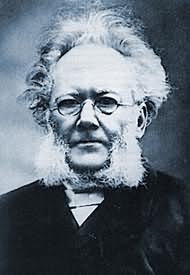Henrik Ibsen's A Doll’s House (act 3)
The question of the day is . . . Is Nora a cheesebrained airhead who abruptly
and inexplicably is transformed into Simone De Beauvoir? Or, is there some
indication earlier in the play that she has some substance and intelligence,
making the “trnsformation” less abrupt?
I. The topic of “masquerade.” A device with which
to structure a minor scene, or instrumental to our understanding?
• Early
awareness of wearing a masque?
• After
the masquerade—Torvald’s excitement
• Dr. Rank’s
comments on future masquerades. (We might also comment on his refusal to wear
the mask of indifference.
• With the
first letter, Helmer’s mask comes off. (As does the Helmer with which
Nora has sustained herself).
• Nora’s
renewed self-definition—out of costume.
How are the steps Nora chooses to find a new awareness of herself necessary?
(Are some of these too extreme?)
II. Christine Linders as a counterpart, or foil, to Nora.
• What is
her original predicament? Caused by?
• What is
her judgment of Nora?
• Her view
of Krogstad’s indiscretions?
Is
there a way that she can be seen as a kind of hero of this text?
 Henrik
Ibsen (1828-1906)
Henrik
Ibsen (1828-1906)